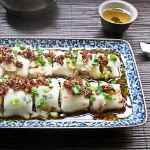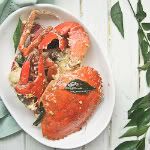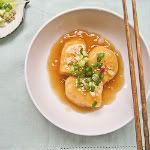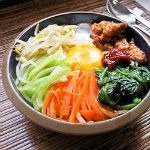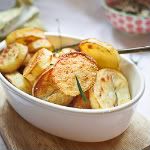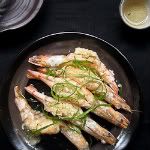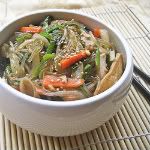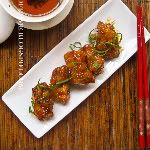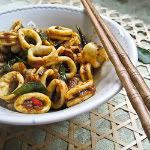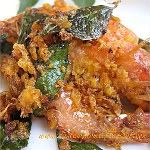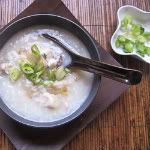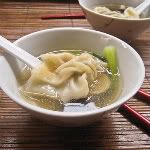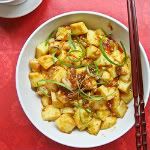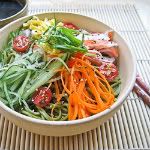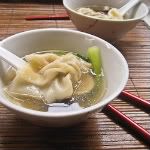Saturday, January 29, 2011 |
Labels:
chicken recipes,
Malaysian recipes,
Poultry recipes,
Spicy
|
15 Comments »
Just like the kam heong squid that I cooked earlier, butter chicken is another unique Malaysian concoction showcasing Chinese, Malay and Indian culinary influences. Bite-sized chicken pieces are first fried, then cooked with butter, curry leaves, bird's eye chilli peppers and egg yolk. The heat in the dish comes from the bird's eye chilli peppers while the butter works exceptionally well with the aromatic curry leaves. Curry leaves are native to India but are widely available in Asia, these aromatic leaves are so named because they are used a lot in curries. I remember going on a wild-goose leaf chase while living in California as I was desperately longing for butter prawns at the time and dried curry leaves just don't make the cut. I finally found some fresh curry leaves in an Indian grocery store after checking fruitlessly in the various Chinese/ Vietnamese grocery stores, so if you are in the US do check out your local Indian grocery stores first.
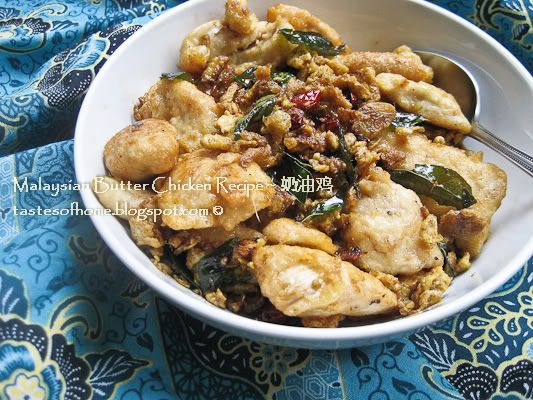
This style of cooking will work well with other types of seafood as well, the most popular being either crab or prawns. The pièce de résistance of this dish however (at least to me) is the little fried-up egg yolk bits that are full of flavour, imagine crispy golden brown bits laden with the aroma of curry leaves and the fragrant spiciness from the bird's eye chilli peppers.
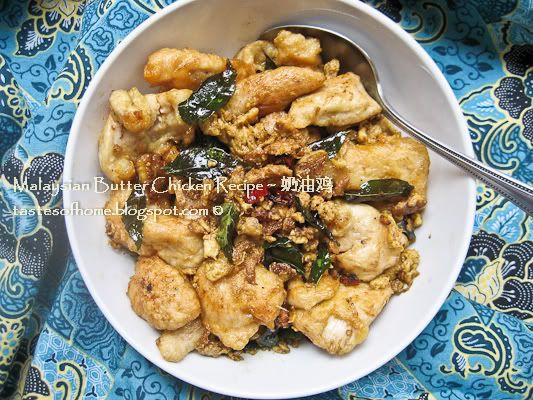
You will fall in love with the golden deliciousness of Malaysian butter style dishes! I hope that you will give this representative Malaysian style of cooking a try and for my fellow Malaysians, do give this easy recipe a try for a taste of home.

Friday, January 28, 2011 |
Labels:
Asian Snacks,
Chinese New Year,
dim sum,
Pork recipes,
Yuen Chun Recipes
|
9 Comments »
As I have mentioned earlier in my honey soy salmon post, I will be collaborating with Yuen Chun, the preferred brand of cooking sauces in our family on Tastes of Home. I was kindly invited to a tour at one of their facilities in Kuala Lumpur yesterday and of course I brought my mom along as a guest, she definitely has been using their sauces way longer than I have! According to mom, my late great grandparents lived near another Yuen Chun facility in Kuala Lumpur and she still remembers looking with curiousity at the giant urns containing fermenting soy sauce while taking a bus ride to visit her grandparents with my late grandmother when she was a child.
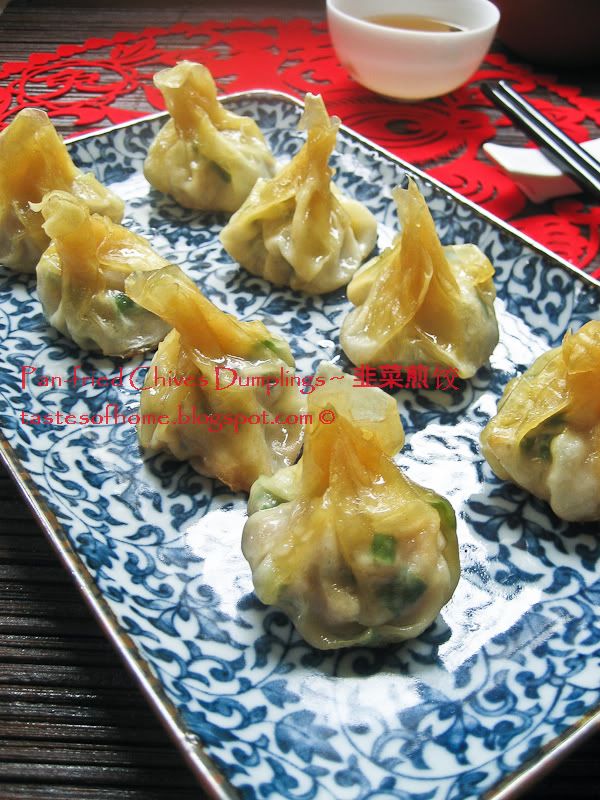
Apart from the taste and quality of the sauces that we prefer, Yuen Chun is more than just a brand of cooking sauces to our family as it has been used in our family kitchens since the time of my late maternal grandmother whom we addressed as 'Popo'. It brings back fond memories of my popo, I still recall how us grandchildren would sit around her listening to her reminiscing about her childhood, sadly by the time I was interested in cooking, my popo's health deteriorated rapidly so I never had a chance to learn cooking from her directly. I am sure though that she too would be elated to know that I am working with her favourite brand of cooking sauces now.

As Chinese New Year is almost knocking on our doorstep, I thought it fitting to present some easy dumplings, twisted at the top to resemble the money bags of ancient Chinese times to my dear readers. I used chives, pork and shrimp as the filling and for a touch of easy luxury, I added Yuen Chun's abalone and chicken sauce. The chives added great texture and flavour to the dumplings while the abalone sauce marinade provided a delicate and pleasing fragrance. I simply pan-fried the dumplings today but these will taste just as good steamed, cooked in broth or deep-fried. Your choice!
Abalone and Chicken Sauce used
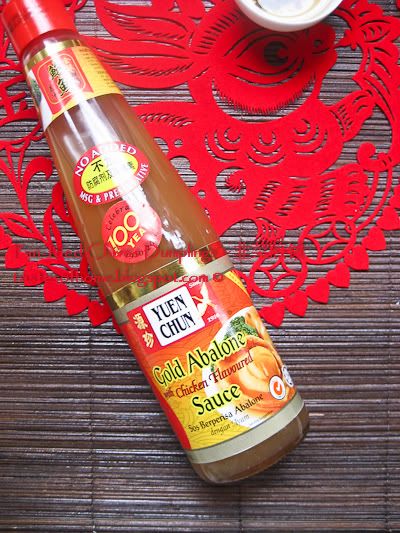

Friday, January 28, 2011 |
Labels:
Presto Pasta Nights
|
3 Comments »
This is the first round-up I am doing for Presto Pasta Nights and it has now reached the 198th instalment! I love participating in this event and I am honoured to be doing this week's hosting. We have a great selection of both classic and fusion pasta dishes this week. Without further ado, let's go through the delicious pasta entries for No. 198!
Entries are posted in the order that they were received
First up, we have Shu Han from Mummy I Can Cook with her mouthwatering and gorgeous Pumpkin Ravioli with Basil Browned Butter. The nutty flavours of the browned butter must have complemented the pumpkin to perfection. The pasta was actually made of sourdough, a healthier alternative according to Shu Han.

Next, we have Beth from Seventh Level of Boredom with her comforting and delicious Creamy Orzo with Peas dish. I love peas so this pasta dish is right up my alley.

Sue from
Cous Cous & Consciousness sent in an appetizing and vibrant dish of
Spaghetti with Shrimp and Lemon Oil inspired by one of my favourite chefs, Giada de Laurentiis. Sue also gave us some insight on her memories of her first trip to the US where she visited San Francisco, definitely one of my favourite cities.
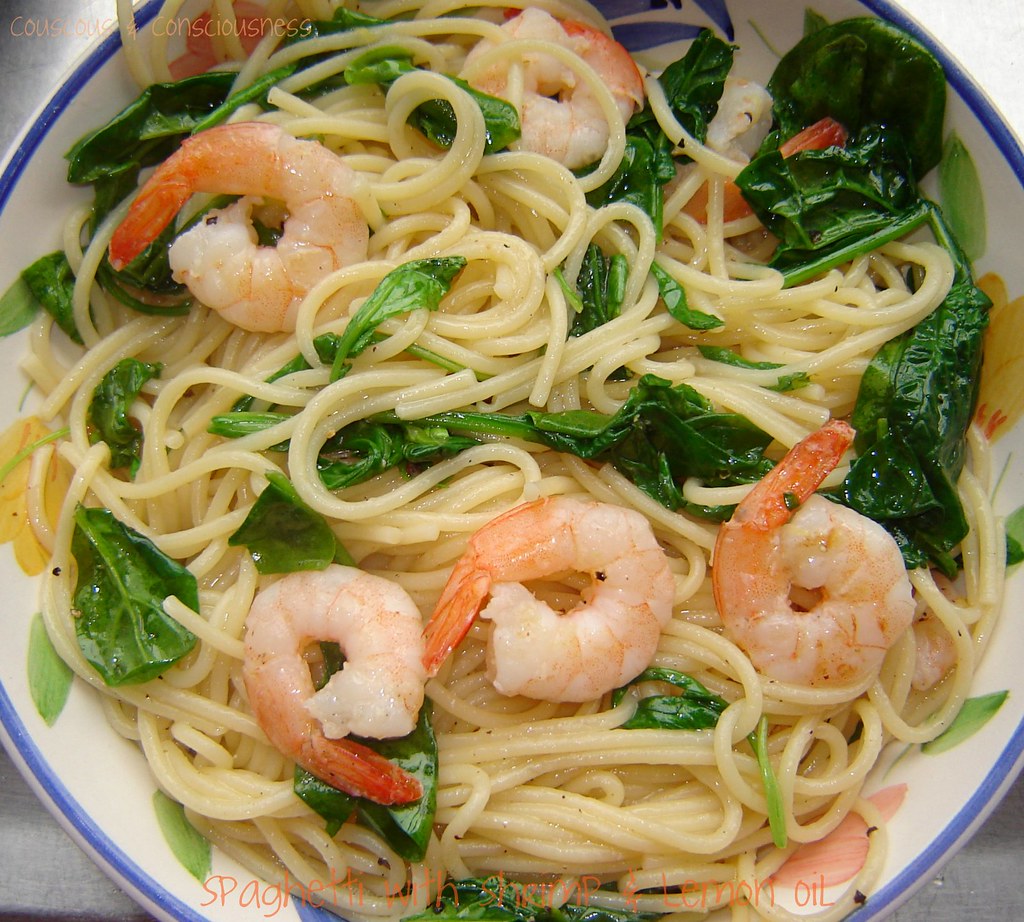

Tuesday, January 25, 2011 |
Labels:
chinese comfort food,
Chinese recipes,
Noodles,
Quick meals,
udon
|
27 Comments »
I am such a huge fan of noodles that it's not even funny, I seriously think noodles are one of the things I can't live without so it is an intrinsic challenge for me to go on any protein-only diet. Today's recipe is my version of the famous and deceptively simple Hong Kong noodle dish, 豉油皇炒面 (soy sauce noodles) using udon. I love using udon as there is not much alkaline water in the latter plus quality is almost always consistent and of course is widely available. This dish was inspired from Hong Kong TVB's cooking show that no longer airs, 'So Good' - I just love the practical cooking tips in the show plus the candid and matter-of-fact humour of the host, 'Ah So'. Such a pity that only 2 seasons were aired.
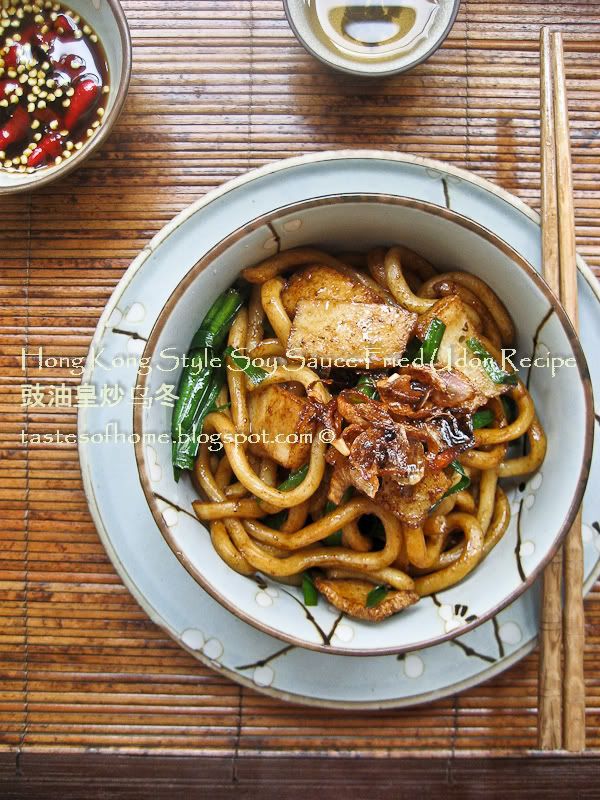
So, armed with some tips that Ah So provided for this everyday yet hard-to-execute-perfectly dish and my own understanding of the noodle dishes, I decided to give this classic a try. Firstly, the udon noodles should be completely dry/ cool after being refreshed in boiling water in order for the noodles to absorb the flavours in the dish. Secondly, it is better to saute each ingredient separately to avoid muddled flavours, much like how fried rice should be cooked. These noodles are usually cooked with beansprouts but I did not have any on hand so I used chives. One interesting tip I learnt from 'Ah So' is that if you are using beansprouts, to get rid of the grassy smell from the vegetables, boil them together with a tiny dash of sesame oil and some ginger slices, then saute them with some garlic (to be removed later) and some green onions.
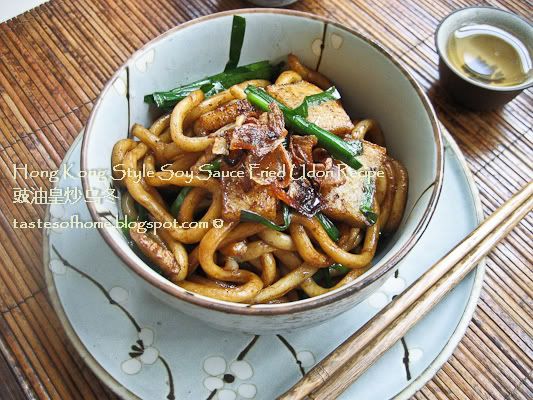
Apart from the delicious flavours, you will love the simplicity of this dish with such a delightfully short list of ingredients. What's more, it is so quick to cook as well - for this noodle dish to be sumptuous however, it is important to use a Chinese wok for the magical 'wok breath' or 'wok hei' since the flavours are so simple. The correct soy sauce to use is mushroom flavoured dark soy sauce 草菇老抽 for the deeper soy flavours and the gorgeous dark mahogany colour that you will not achieve with regular light soy sauce. (note: this is not the thick soy sauce used a lot in South East Asian cooking though of course you can use that but it will be a different dish altogether). Dark soy sauce is aged longer than light soy sauce which is probably why its' Chinese name literally translates to old soy sauce. It contains added molasses and the longer aging time produces a richer and deeper tasting soy flavour, hence is used more in cooking rather than as a dipping sauce unlike its' 'lighter' counterpart.
This is my entry to this week's Presto Pasta Nights hosted by myself for the very first time. Check out this announcement I made earlier on how to participate.
Photo featured on front page of Serious Eats on January 29, 2011


Sunday, January 23, 2011 |
Labels:
curry,
Fish recipes,
Malaysian food,
Quick meals,
Seafood Recipes,
Spicy
|
12 Comments »
Fish head curry has its' own cult following in Malaysia - there are restaurants solely dedicated to fish head curries, probably not surprising as most fish aficianados say the cheeks of the fish are the most succulent and best parts for eating. At first glance though, fish head curry may look daunting to the uninitiated - I still remember how confused I was as a child looking at the giant fish head sitting on the equally giant platter wondering just how I was supposed to go about eating it. Of course, the giant eyes staring back at me from the plate did not help. My memory is a bit hazy but I recall my dad going for the eyes and if you think fish has a lot of protein, think at least twenty times more for the eyes. My dad claims that is the main reason why he has very good vision, because he eats a lot of fish eyes!
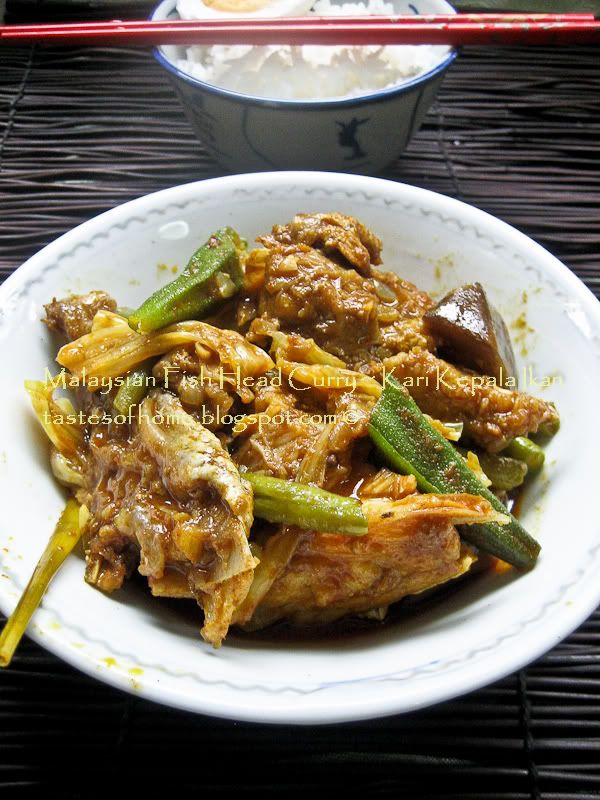
Today's recipe is extremely easy - you can make an authentic and delicious curry dish with store-bought curry paste as long as you add some touches of your own. If you are going for the fish head, do get your fishmonger to chop the heads up to make your prepping and cooking easier. I used garoupa head which is recommended by my mom as garoupa does not have a strong fishy taste which is a real turn-off in fish head curries. That is why we prefer to cook our own as the freshness of the fish is guaranteed. If fish head sounds too exotic for you, feel free to substitute with fish fillets. The fish pieces are first deep-fried before cooking in the curry to ensure the fish does not fall apart and turn into mush. If you like fish and curries, do give this a try!
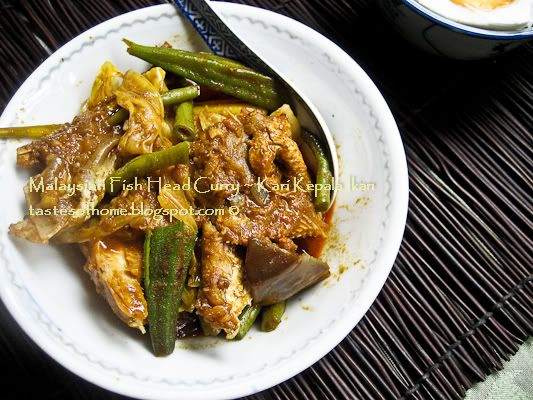
For my Malaysian curries, I prefer the A1 brand. They have a great selection of curry pastes that so far tastes the best to me. I love having a lot of vegetables in my curries as well and for today, I added eggplants, long beans and cabbage, essentially making my curries easy one-dish meals.

Friday, January 21, 2011 |
Labels:
Chinese recipes,
Fish recipes,
Quick meals,
salmon,
Seafood Recipes,
Yuen Chun Recipes
|
12 Comments »
As some of you may already know, I am a big fan of Yuen Chun cooking sauces especially for my Chinese cooking needs, a preference handed down by my late maternal grandmother who was an excellent cook. I still think that her special way of making Quaker's Oats tastes the best ever, something I have not been able to replicate, I was too young then to ask for cooking tips! Today, I am extremely excited to announce that I will be working with the lovely folks at Yuen Chun on projects for this blog. First off, Yuen Chun will be generously sponsoring a giveaway on Tastes of Home so that you, my lovely readers would get to try out their products that I have been touting forever in a lot of my recipes like my braised pork in sweet soy sauce, sweet and sour pork and ginger soy chicken amongst many others. Yuen Chun recently celebrated its' 100 year anniversary in the business and its' products are favourites amongst many Malaysian cooks for both the authentic flavours and consistent high quality.
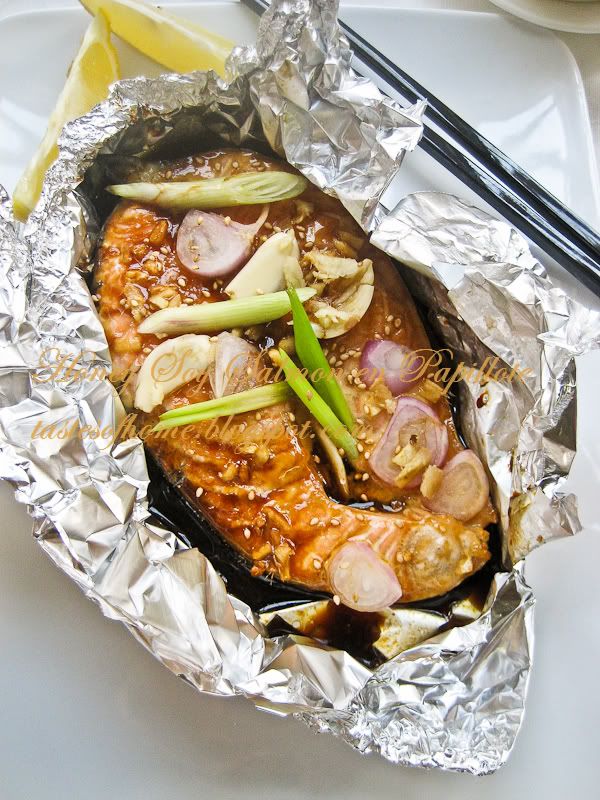
For today, I created a salmon dish that uses Yuen Chun's famous thick soy sauce - a rich and deep blend of soy sauce, sugar and caramel that lends a pleasing flavour and provides a gorgeous glaze to many dishes. Today's dish is rather like a fusion dish as I used one of the classic French cooking methods, en papillote which means 'in parchment' but can refer to food (usually fish, vegetables or poultry) cooked in foil as well. This method of cooking aims to keep the natural juices and flavours of the food intact while maintaining moisture which I think is imperative especially while cooking fish whereas I chose Asian ingredients for the condiments.
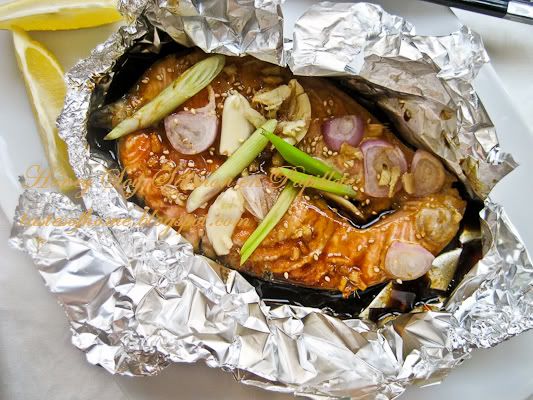
Apart from the elegant appearance of en papillote dishes, don't you just love the fact that there are less dishes to clean up? Serve your guests with the packages unopened at the table, they will definitely relish unwrapping their elegant little parcels and will be greeted first thing with the luxurious aroma of flavourful salmon. Definitely a great dish to add extra flair at your next dinner party!
Yuen Chun Thick Caramel Sauce
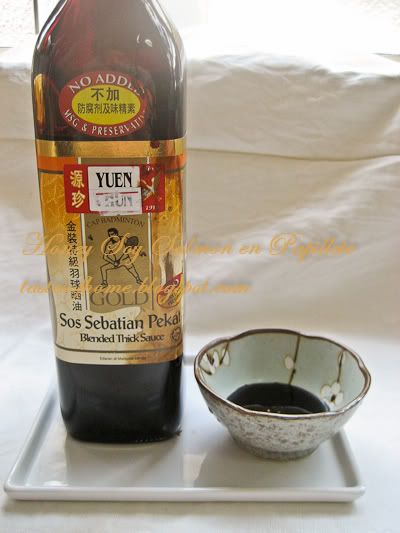

Friday, January 21, 2011 |
Labels:
Announcements,
Presto Pasta Nights
|
No Comment »
I will be hosting for Presto Pasta Nights No. 198! (198 is such an auspicious number too - the Chinese in me is extra excited!) This is a blogging event created by the lovely Ruth of Once Upon A Feast that I have regularly participated in. Rules for participation are very simple, just create a pasta or noodle dish and post it to your blog during that week then send in the relevant link to your recipe and a round-up of all the pasta/ noodle dishes received will be done. I have always enjoyed participating in Presto Pasta Nights and I am excited to be doing my first-time hosting this time. It is a great opportunity to introduce your favourite pasta or noodle dishes to the wonderful community and at the same time discover fun new blogs.
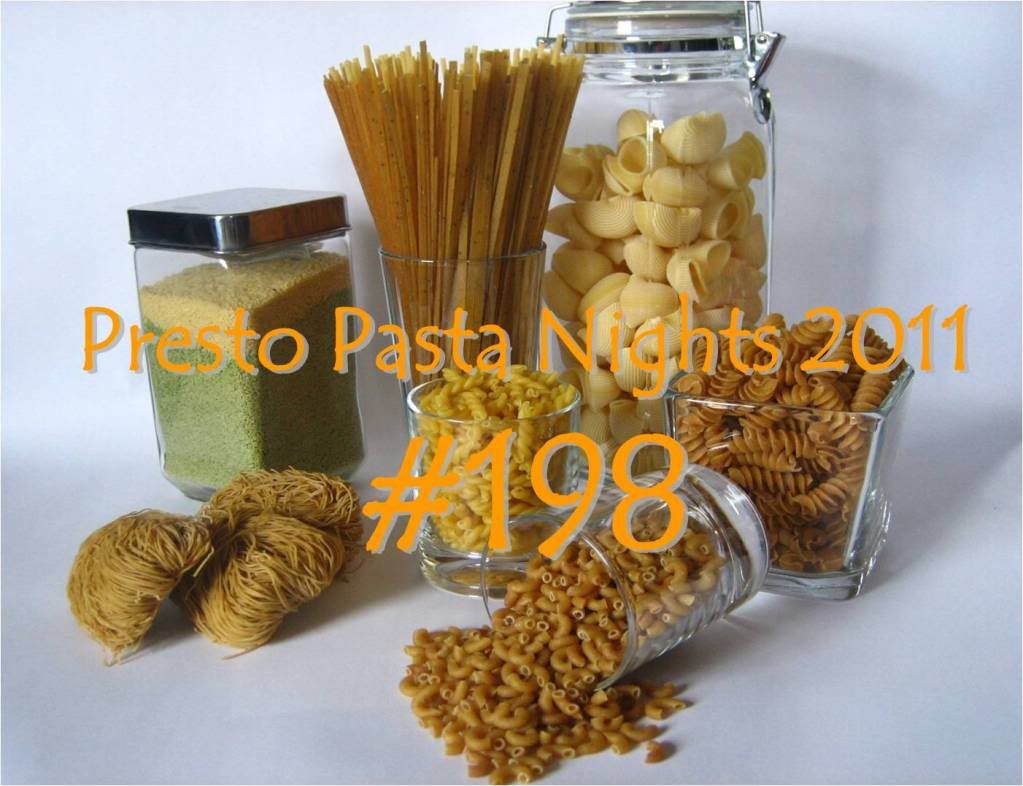
I had originally wanted to create a dish to go with this announcement but I have been feeling under the weather lately so I am sharing some of my recent entries to the event for you to get an idea. Please click on the photos for the recipe.
First up, the Korean favourite of Jjajangmyeon, wheat noodles in black bean sauce - a descendant of the Chinese Zhaziangmian..
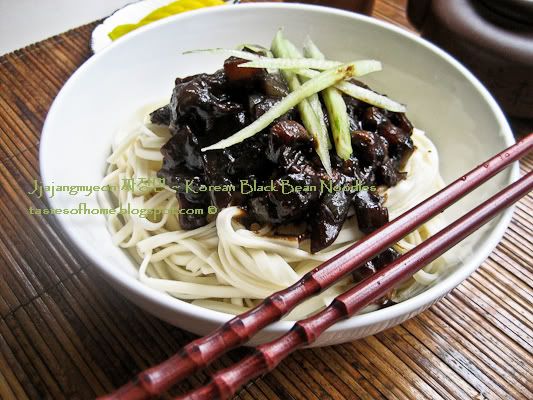
Next, rice noodles in broth with roasted duck and shimeji mushrooms - something I created to make use of leftover roast duck!

Finally, a 'real' pasta, macaroni cooked Asian style with carrots and shallots.
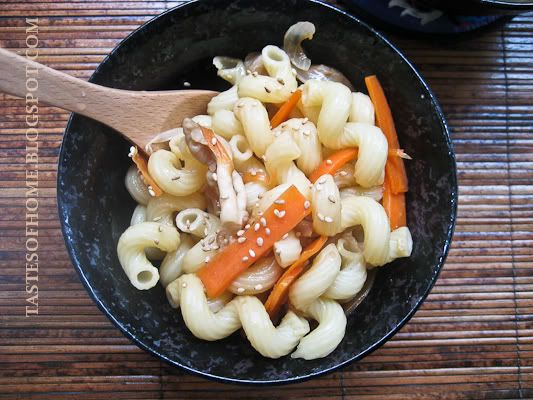
Kindly mail in your entries to tastesofhome[at]gmail[dot]com and cc to ruth[at]4everykitchen[dot]com including your blog link to the pasta/ noodle dish you created together with a photo of your choice for the dish in jpg format by January 28 (Pacific Standard Time) and state Presto Pasta Nights 198 on the title of your email. In addition, please provide a link to this announcement on your post which you will be submitting for the round-up. I look forward to your entries!

Wednesday, January 19, 2011 |
Labels:
chicken recipes,
Indian Recipes,
Malaysian recipes,
Poultry recipes
|
10 Comments »
Growing up in Malaysia, I have been exposed to Indian cuisine since childhood and I am a big fan of a lot of Indian dishes. Most of the Indian dishes found in Malaysia are said to be from the southern part of the country as immigrants brought in their cuisine years ago. Now, of course there is a breed of unique 'Malaysianised' Indian cuisine that is no less delicious so I am not sure how authentic my recipe for tandoori chicken is but it is definitely delicious and easy to make. Traditionally, tandoori chicken is cooked in a clay oven known as a tandoor which incidentally is also the kind of oven used to cook naan, the famous Indian bread that complements tandoori chicken perfectly. I believe that tandoori chicken hails from the Northern part of India and started becoming extremely popular during the time of the Mughal Empire in Central and Southern Asia.
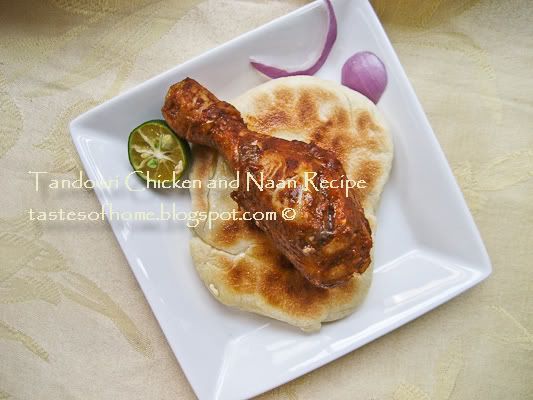
For today's feature, I simply marinated my chicken drumsticks overnight in some yoghurt, garam masala, chilli powder and calamansi lime juice. I then roasted the chicken in my oven, but you can opt to place it on the grill - tandoori chicken by the way is widely known as India's very own version of barbequed chicken. As I roasted my chicken in the oven, it lacked the characteristic smoky flavours but was still pretty delicious, but if you have a barbeque grill, I would suggest using that instead of baking in the oven.

I was actually a bigger fan of the naan I made today, the first time ever for me to make naan from scratch! It was an incredibly fun exercise for me to make (successful!) naan and I am already getting requests on when I will be making them again from my guests! Honestly speaking, I was apprehensive while making the naan after reading countless failed attempts by others all over the web - it was such a relief that they turned out well. Instead of toasting my naan in the oven since I don't have a pizza stone, I pan-fried the naan which worked out very well.
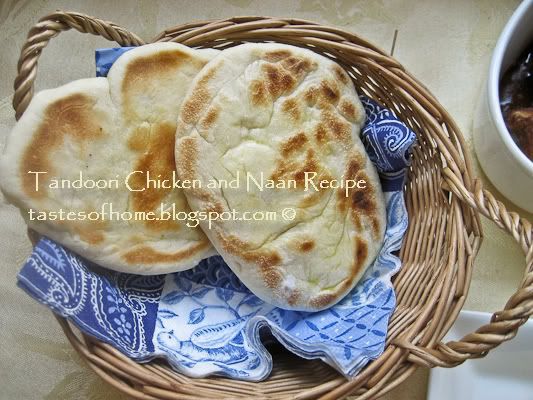
If you are a fan of naan and would like to try making it at home, you have to try this - I promise you will not be disappointed!

Monday, January 17, 2011 |
Labels:
kam heong squid,
Malaysian recipes,
Seafood Recipes,
squid
|
20 Comments »
The 'kam heong' (金香) method of cooking is uniquely Malaysian and is a culmination of cooking styles and ingredients from Chinese, Malay and Indian influences. Kam heong literally translates to 'golden fragrance' from the Cantonese dialect and is an extremely popular method of cooking in Malaysia, most famously seen in a crab dish,aptly named kam heong crab. Yes, the Chinese love to name their dishes with auspicious names which sometimes have nothing to do with the ingredients used. (We do have our little quirks.) For today's feature, I decided to use squid and the results are no less decadently delicious, the piquant and heavenly aroma alone is enough to make me drool. The squid is simply cooked quickly in some hot oil, then stir-fried together with the sauce. By the way, although kam heong sounds auspicious- my mom reminded me that I should not cook this squid dish at Chinese New Year since I am stir-frying squid as in Cantonese slang it means getting fired from work (炒鱿鱼)!

The essence of the dish is the sauce where the richly flavoured sauce is a potent combination of finely chopped dried shrimp, bird's eye chilli peppers, curry powder and curry leaves. The gorgeous aroma of the curry leaves is irreplaceable and gives this dish its' distinctive umami-filled flavours. It is definitely more than worth your while to hunt these leaves down and if you are living in the US, your best bet would be to find them at Indian grocery stores rather than Chinese or Vietnamese ones. I am such a huge fan of kam heong dishes that is hard to put into words and I am more than capable of finishing up a bowl of rice with the fragrant sauce on its' own. Anyhow, the toothsome squid adds great texture to the dish and you will definitely not regret trying out this representative Malaysian style of cooking!
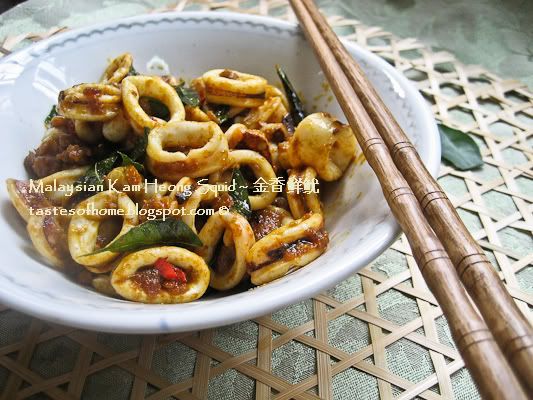
I am also sending this entry to Muhibbah Monday, a blog event created by 3 Hungry Tummies which will be hosted by Sharon of Test with Skewer for January 2011. This is an event which rounds-up Malaysian recipes/ food blog posts each month. Check out the links for more details.

Recipe featured on Asian Food News section of Newsodrome

Photo featured on front page of Serious Eats on January 19, 2011


Wednesday, January 12, 2011 |
Labels:
Cantonese dishes,
Chinese food,
Pork recipes,
Yuen Chun Recipes
|
26 Comments »
Sweet and sour pork or 咕噜肉 is undisputedly one of China's most famous dishes and exports. Of Cantonese origin, this winning combination of crispy and crunchy pork bites coated in a vibrant sweet and sour sauce has captured the appetitites of many both in and out of China. I am so excited today to announce that I have finally discovered the perfect recipe for sweet and sour pork! The secret? Instead of using vinegar for the sour element in the sauce, I used plum sauce (苏梅酱) which lends a deeper and more natural fruity sourness to the sauce. Sauce solved, what about the pork? One of my pet peeves when it comes to sweet and sour sauce is soggy and greasy pork - for a guaranteed crunchy and non-greasy bite, fry the pork twice. This is also a two-part batter in that the pork is first marinated in egg, a little custard powder, corn flour and a tiny bit of water then dredged in a mixture of all purpose flour, corn flour and rice flour. Perfectly crispy golden nuggets have never been this easy!
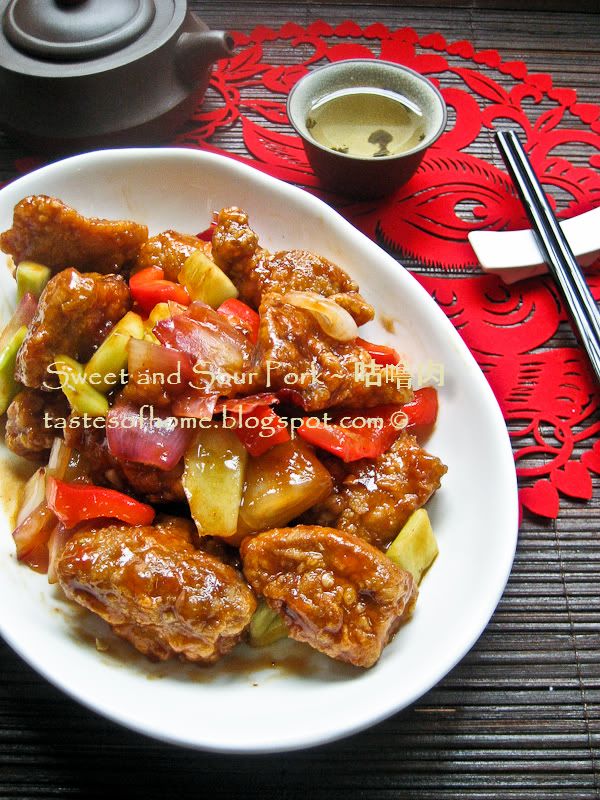
Although sweet and sour pork is a commonly seen dish in every Chinese eatery including many takeout places, it is not easy to cook sweet and sour pork well. Hence, it should be of no surprise that a Cantonese chef is often tested based on the quality of his sweet and sour pork and another classic Cantonese dish, stir-fried flat rice noodles with beef (干炒牛河).The pork has to stay crunchy, yet well infused with the sweet and sour sauce and must not be soggy. Another similar dish that is also one of my favourites is Peking spareribs, the Northern cousin (and some say the ancestor) of sweet and sour pork. There are also many variations of sweet and sour pork now - for instance, when sweet and sour pork migrated to Korea, it became known as tangsuyuk (탕수육) and can actually be made with beef or pork.
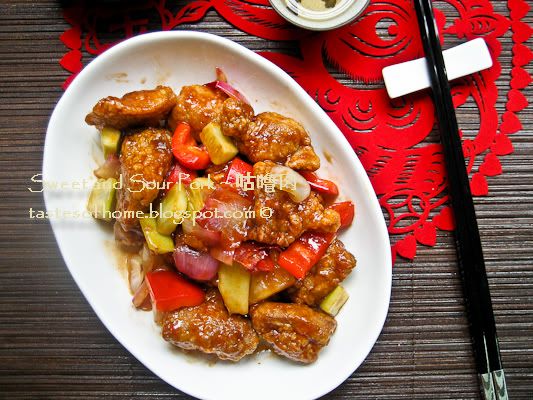
If you are a fan of sweet and sour pork, you absolutely have to make this - satisfaction guaranteed by Tastes of Home!

Monday, January 10, 2011 |
Labels:
Asian Hors-d'oeuvres,
Asian Snacks,
chicken recipes,
Poultry recipes,
Thai
|
12 Comments »
Pandan leaf wrapped-chicken is another favourite Thai dish of mine. These fragrant and delicious chicken bites make great hors-d'oeuvres and can also be served as a main dish with other dishes. The pandan leaf or screwpine leaf is an indispensable ingredient in a lot of South East Asian cooking, from sweet desserts to savoury main dishes. The pandan plant has long and narrow sword-like leaves that impart a sweet, floral and grass-like fragrance when bruised or torn. Also known as the 'vanilla of the East', it is widely used as a natural food colouring agent.
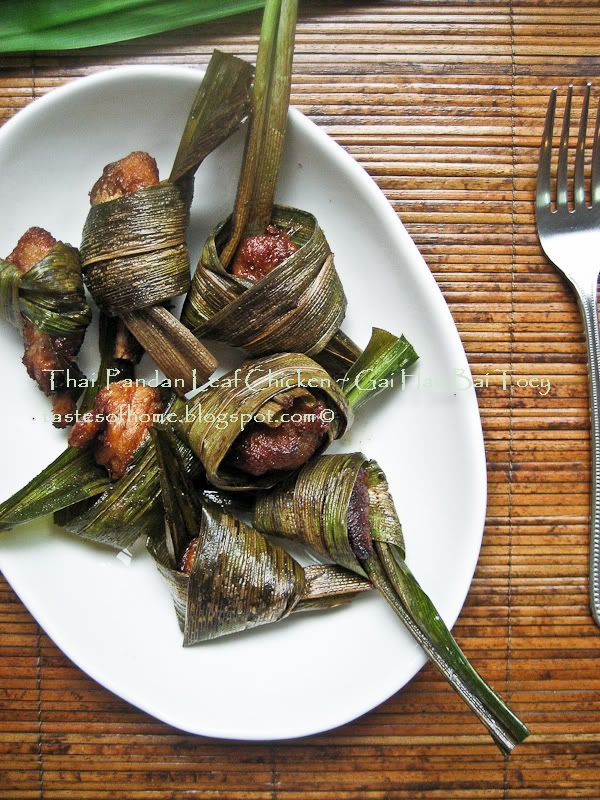
The marinade I used for the chicken today is extremely simple, consisting mainly of some red curry paste, soy sauce and fish sauce. For the unmistakable Thai flavour, I added some bruised kaffir lime leaves and some smashed lemongrass stalks to the marinade. The chicken pieces were wrapped in the pandan leaves in a knot-like fashion where you simply make a knot in the middle of the pandan leaf but with the piece of chicken inside. If you are pressed for time or are not fond of knotting, just simply roll up the chicken in the leaf and secure with a toothpick. I deep-fried the chicken today but you can roast the pandan-wrapped chicken in the oven as well. Pandan leaves can be found in most Asian grocery stores in the frozen or refrigerated section, it may be a little difficult to get fresh ones though. Fresh ones are the best of course but frozen ones are definitely acceptable.
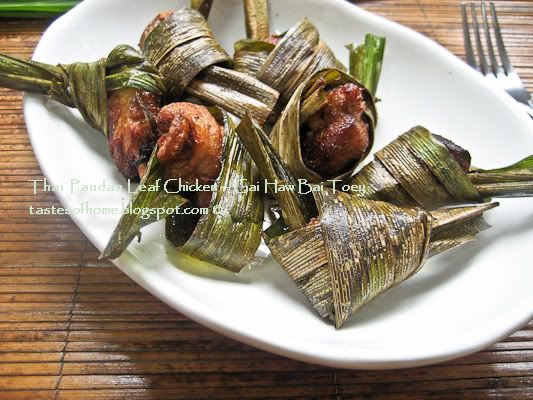
Try this at your next party - these enticing chicken bites will definitely prove to be crowd-pleasers!
Note: The pandan leaves are used only to impart flavour and not eaten.
Photo featured on front page of Serious Eats on January 12, 2011
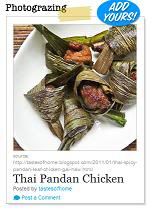

Thursday, January 06, 2011 |
Labels:
Asian Comfort Food,
Korean Food,
Noodles
|
22 Comments »
Jjajangmyeon has reached cult status in Korea and is hailed as one of the country's national dishes, it is probably the most popular delivery noodle dish and is definitely one of the most delicious Korean noodle dishes in my opinion. The early ancestor of jjajangmyeon is the Chinese classic black bean noodles or known as zhaziangmian 炸酱面- both names literally translate to 'fried sauce noodles'. Most of the Chinese dishes found in Korea hail from northern China due to geographical proximity and were brought in by Chinese immigrants to Korea via the Incheon port about 100 years ago. Jjajangmyeon however bears little resemblance to the original in both method of cooking and taste. Jjajangmyeon includes a lot of different vegetables like zucchini, carrots, potato and radish in the sauce while a typical Chinese cook would probably never dream of adding such into zhaziangmian. Different as these dishes are, I find both versions delicious and as is traditional, I love eating my jjajangmyeon with danmuji (yellow pickled radish) which is also an essential ingredient when making kimbap.
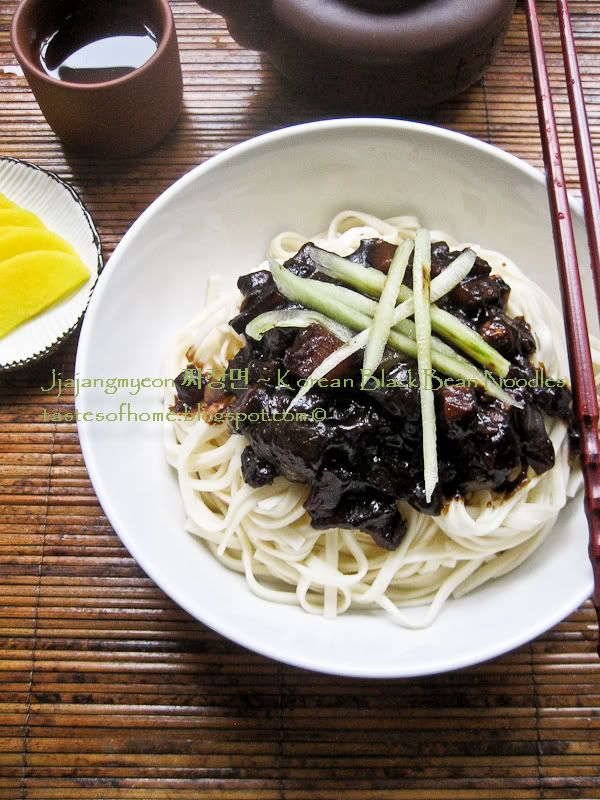
In a typical Korean Chinese restaurant, jjajangmyeon is usually made with freshly handmade noodles (sutamyeon) while the mainstay of the sauce is chunjang (pictured below), a paste made from roasted soybeans and caramel. I did not have the luxury of fresh handmade noodles, hence I used a dried variety of wheat noodles used for jjajangmyeon (pictured below) - if you can't find these noodles either, you can substitute with other wheat noodles or even linguini. If you are Asian, it is probably hard to be ignorant of hallyu - the Korean wave referring to the widespread 'exportation' of Korean culture especially via the country's entertainment industry to most parts of Asia. Admittedly, I used to be addicted to such dramas but nowadays if I do catch one, my eyes will be more glued to the food since as a food blogger, I am constantly on the look-out for new cooking ideas - such is the life of a food blogger! Jjajangmyeon features heavily on a lot of Korean dramas' menus, one is almost always bound to see the characters slurping up these yummy noodles. Looks like Korean dramas are now doing what Chinese immigrants used to do i.e. introducing its' cuisine to foreigners!

I am sending this as an entry to Presto Pasta Nights for 2011's first round-up hosted by the creator herself, Ruth of Once Upon A Feast. Check out the links for more details on how to participate.

Wednesday, January 05, 2011 |
Labels:
curry,
Quick meals,
thai recipes
|
4 Comments »
Here's a spicy start to 2011! Today's feature is my version of one of Thailand's myriad of famous curry dishes, red curry. I chose chicken as my protein of the day but feel free to substitute with other proteins of your choice, including seafood as well. I like to have vegetables in my curries and today's dish includes eggplants or otherwise known as brinjal and green beans. The soft texture of eggplants complement the more toothsome texture of the green beans extremely well and with the addition of vegetables, you get both your vegetables and protein in one delicious dish.
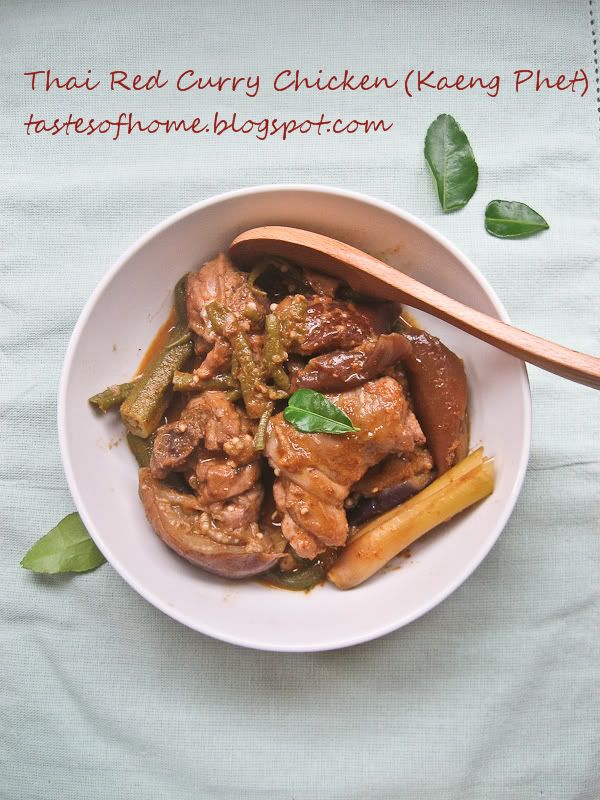
Aromatic lemongrass and kaffir lime leaves are a must in Thai curries - the unique fragrance imparted is essential to a yummy Thai curry dish much like how curry leaves are essential to a lot of Malaysian curry dishes. You can also opt to use Thai sweet basil instead of kaffir lime leaves according to your preference although I prefer the former. Thai red curry is typically the strongest of Thai curries while green curry is usually considered the mildest curry. With the easy availability of tasty curry pastes nowadays, a delicious pot of curry is almost effortless and is extremely quick to prepare with some caveats of course. One, I prefer fresh pastes to tinned ones and also it is vital to add some simple ingredients to your pastes i.e. garlic, shallots, lemongrass and kaffir lime leaves for added aroma. Fish sauce provides the final touch and here you have it, an easy and speedy yet guest-worthy curry dish!
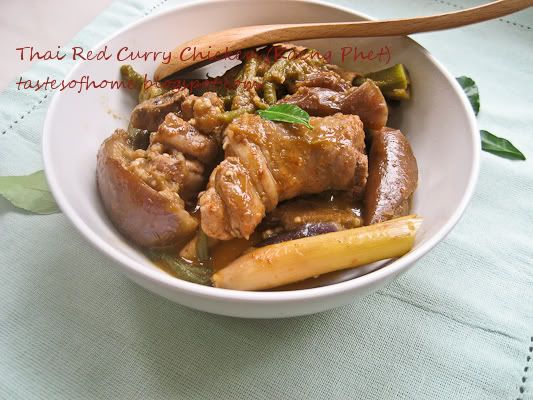

No content from this website including images, recipes, writings may be reproduced without prior consent from the author.




 Subscribe to Feed
Subscribe to Feed






































